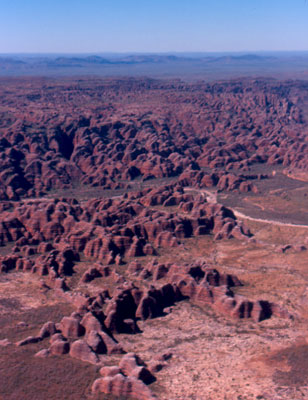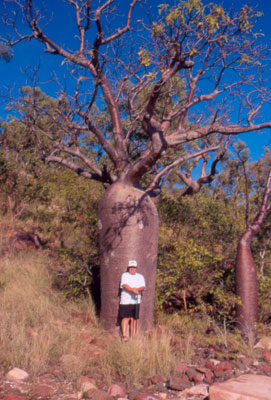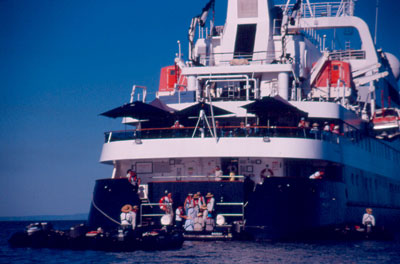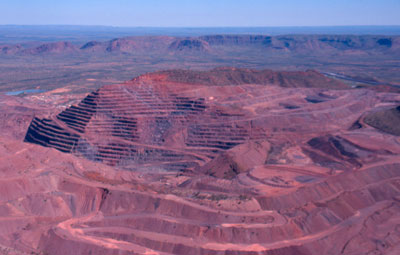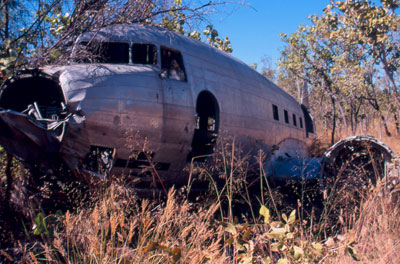Cruising Australia’s Kimberley coast
by Bill Altaffer, San Diego, CA
I was among a group of 81 Australians and two Americans who arrived in Broome, Western Australia, in June 2010 eager to embark on a 10-day expedition cruise along the Kimberley coast to Darwin aboard the MV Orion. The Orion is a purpose-built ship, capable of exploring the bays and inlets of this dramatically beautiful, unspoiled coastline, home of saltwater crocodiles, pearl farms and Aboriginal rock art.
Luxury accommodations
Included in the cruise package was one night in Broome’s only five-star resort hotel, the Pinctada at Cable Beach. This luxurious, very comfortable hotel is located near Broome’s historical Chinatown, with its many cafés, pearl stores and colorful gift shops.
Broome, with a population of about 15,000, is the largest town in the Kimberley, the 164,000-square-mile area that comprises the upper part of Western Australia. There are only two paved roads that traverse this largely undeveloped area.
After a restful night at the Pinctada, our luggage was whisked off to be loaded onto the Orion while we spent time exploring Chinatown before being bused to the dock to board the ship.
We all know people who seem to travel only to complain. If a person had complaints about the Orion, he would surely be someone impossible to please.
As a veteran of approximately 20 expedition cruises with most of the different cruise lines, I feel qualified to say that none has done a better job than Orion did for us. The entire ship is exquisite, opulent and beautifully designed with class and function to provide a five-star experience.
All staterooms, even the lower-priced ones, are large and roomy, with queen-sized beds, elegant furnishings, flat-screen TVs and DVD players. We were able to keep up with world news (BBC and CNN) and could borrow DVDs from the well-stocked library.
The dining room, lounge and library are just as beautiful as the staterooms. Another classy feature is the glass elevator, surrounded by a circular staircase.
Every detail and furnishing of the ship speaks of quality, reminiscent of a luxurious five-star hotel. I tried to find a fingerprint on the glass, bronze, chrome and mirrored surfaces, but the Orion staff kept these immaculately free of smudges.
Life on board
The ship has a spa with masseuse, a gym, a sauna, a beauty salon, an outdoor café and two lounges. Its library, besides having multitudes of books and DVDs, is stocked with a large assortment of board games.
Its lecture hall is the nicest, most comfortable and most efficient I have seen on any ship. All decks have handicapped access. The ship also boasts an embarkation platform for Zodiac operations.
The food on board was exceptional in quality and variety. The menu was created by Chef Serge Dansereau of Bathers’ Pavillion on Balmoral Beach in Sydney, one of Australia’s finest restaurants.
Any and all diets were taken into account. The staff was always aware of who needed a special item (for example, gluten-free toast), and that item would appear without the passenger even asking for it. That was very impressive, considering the number of passengers on board.
All expedition cruises include lecturers, and Orion’s sailing was no different. We had great lectures on history, geology and Aboriginal culture and rock art.
In my experience, no expedition cruises include entertainment. In this, Orion was different. We had a singing piano player who performed during Happy Hour and after dinner. He was excellent.
Since Australians customarily do not tip, tipping was not expected on the Orion. Therefore, the crew’s friendliness and attention to our comfort was not based on the expectation of monetary reward. Our cruise of 83 people was served by 76 staff and crew, a ratio that insured excellent care.
Mike Taylor, the ship’s captain, was a very colorful and friendly addition to the experience. He would join us frequently, in particular at the buffet breakfasts and lunches on the back deck.
He commented that most cruise ships in today’s world are focused inwardly — the ship, itself, becoming the experience; the cruise destination hardly matters any more. But on Orion, though passengers are pampered on board, the focus is on experiences off the ship. The Kimberley coast was a perfect route for such a ship.
Daily excursions
Every day along the coast, we had disembarkations or Zodiac cruises that were included in the fare. In addition, at most of the stops, there were optional excursions that could be enjoyed for costs ranging from AUD60 to AUD475 ($59-$470).
Every effort was made to insure that a person could participate in the included activity as well as the optional one, if interested. This was possible with very few exceptions, in spite of logistical difficulties.
One of the interesting optional activities was fishing. A professional fishing guide was on board along with his fishing boat. Each day, his boat was unloaded from the ship for a morning and an afternoon fishing excursion for two to four participants each time.
Another feature that, in my experience, was unique to Orion was its having a tender in addition to the multitude of Zodiacs for the daily excursions. For those individuals who found getting in and out of a Zodiac physically challenging or who preferred to be under shade rather than in the tropical sun, the tender was available. It could not go quite everywhere the Zodiacs went, but it allowed those people to experience most of the excursions rather than remain on board.
As for the Zodiacs, each was outfitted with three seats when the excursion involved long cruising. Yes, seats… with backrests! While each bench seat could hold three people, Orion’s policy is to load no more than six in a seated Zodiac. This enhanced the cruising more than I can express, providing comfort that was very easy to get used to.
Natural beauty
After departing Broome on the afternoon of June 10, we sailed toward Cape Leveque for our first Zodiac landing the next day. This would be our only chance to enjoy a beach during the cruise, due to the presence of saltwater crocodiles (salties) everywhere else.
Cape Leveque is a stunningly pristine, miles-long expanse of sparkling white sand with a backdrop of dunes and red-orange sandstone. It is Aboriginal land, so we were not allowed to wander back into the dunes, but there was plenty of beachfront to explore.
The water was crystal clear and refreshing, perfect for swimming. It was an idyllic afternoon in a true tropical paradise. Of course, the Orion staff was on hand, under a big blue umbrella, with water, juice and sunblock.
The next day we were in Talbot Bay, home of the Horizontal Waterfalls. The entire Kimberley coast is a geologist’s dream. The red sandstone cliffs keep a dramatic record of forces and processes that occurred over millions of years, including sedimentary layering, upthrusting, folding and buckling. Every cliff has visible layers of rock, some tilted vertically and folded back over, creating a very beautiful, unique landscape.
At Talbot Bay there were two rows of sandstone cliffs with narrow gaps in them, allowing water to flow between the rows of cliffs and behind onto the shore, with daily tidal changes of 30 feet. When these huge quantities of water surge through the narrow gaps, the result is the dramatic Horizontal Falls.
Another highlight of this enjoyable Zodiac cruise was spinning in whirlpools and vortices when we passed between the two cliffs. We cruised between them, along their edges and occasionally right into them for an experience unlike any I had ever had.
Before heading back to the ship, we managed to puncture one of the chambers of our Zodiac. Orion staff cleverly created a temporary patch using bandages from the first-aid kit.
Interesting excursions
The following day, we disembarked at Raft Point for a steep climb up to view old Aboriginal rock art in a saddle of rock high above the sea. This outdoor art gallery depicted an account of the mythical Wandjina on a Great Fish Chase and was well worth the climb.
We also saw our first boab trees at the landing site. These are related to the baobabs of Africa and Madagascar and appear alien in form, much as the Wandjina do.
The afternoon Zodiac cruise at Montgomery Reef was another unique experience. The reef is huge, covering 400 square kilometers, and is submerged during high tide. We boarded our seated Zodiacs and began cruising away from the ship through what appeared to be completely open water.
Before long, the tide began to go out and the top of the reef began to appear before our eyes. Soon, water was rushing off the reef, forming streams and cascades in a raging torrent. It became obvious that we were in a channel with reef on either side of us.
As the water continued to flow off the reef, numerous birds — egrets, cormorants and sandpipers — landed on it, foraging for sealife trapped on the reef. We cruised the channel, watching the amazing sight of the reef continuing to emerge until the sun was low in the sky, then headed back toward the ship.
Exploring further
By the following morning, we had arrived at our next destination, Mitchell River National Park, one of the nation’s newest and most inaccessible parks. The Mitchell Plateau is scenic as well as biologically important, including small patches of rainforest along its margins and open woodlands growing around valleys and by creeks.
The park contains 50 species of mammals, 220 species of birds and 86 kinds of reptiles.
The day’s included activity was an exploration of the mangrove environments of the Hunter River and Porosus Creek, seen comfortably from our Zodiacs.
Since each Zodiac was limited to six passengers and the cruise lasted almost three hours, we were split into two groups, for morning and afternoon cruising. Due to the wild tidal fluctuations, the morning group zipped among and between mangrove trees, the treetops emerging from the water, while the afternoon group cruised by the same trees now completely exposed on mudflats. Both groups saw numerous salties and abundant bird life.
The backdrop for this amazing experience was the ever-beautiful red sandstone cliff that lined the gorge created by the river.
After cruising along the coast overnight we arrived at Vansittart Bay, where we made two landings. In the morning we took a short, guided walk away from the beach to the site of a crashed C-53 aircraft, a relic from World War II.
In the afternoon we cruised over to Jar Island, where we visited two Aboriginal rock art galleries. These were in the Gwion Gwion style, also referred to as the Bradshaws, which is completely different from the Wandjina art we had seen earlier.
To the falls
By the following morning we had arrived at the mouth of the King George River, where helicopter rides to the falls were an optional activity.
Those who opted to enjoy only the included activity had two options. Both options started with a Zodiac excursion to the river’s double waterfalls, a trip that took a good hour each way, including side trips up canyons for the scenery, wildlife and birds.
The more hardy group disembarked their Zodiacs a distance below the falls to scramble up the nearly vertical wall in what was a difficult climb over tumbled boulders and through vegetation.
At the top, a walk of about half a mile brought participants to the top of the first of the two falls. There was time for exploring and swimming in the pools there. Most people crossed the first river, then made their way across the broken landscape so they could also enjoy the view from the top of the second, much larger waterfall.
After about an hour, the group clambered back down to the waiting Zodiacs. Both groups headed toward the falls.
When we were near the falls, we rounded an outcropping of rock. There, hidden from our approach, we found Orion staff in a Zodiac under their blue umbrella with a tray of champagne flutes half-filled with orange juice.
At our arrival, they popped open a bottle of champagne with great ceremony, finished filling the flutes and handed them to us along with delicious ham-and-cheese croissants. This was completely unexpected, instantly changing the mood from mere pleasure to festive gaiety.
As we ate and drank, we cruised around close to the falls, enjoying the sheer beauty and majesty of the location. We then were instructed to gather up all items that needed to stay dry and leave them in another Zodiac while we zipped under the smaller of the falls! The squeals and laughter from everyone as each Zodiac passed under the blast of cold water only added to the festivity.
From the air
The next morning found us at an actual dock in an actual town, Wyndham, the northernmost town in Western Australia and the first sign of human habitation we had seen for a week. With a population of only 1,300, Wyndham served as the gateway to our day’s adventure.
Shuttle buses operated hourly from the ship to take passengers to the few points of interest in the town. Each person could choose one of two included options: a cruise down the Ord River to Lake Argyle or a scenic flight over the Bungle Bungles.
Those who chose the river cruise spoke highly of their adventure. I opted for the flight.
Our group was bused to the local airport, where we boarded small airplanes, four passengers to each one, allowing everyone a window seat. The windows were specially constructed with curved glass so you could easily look straight down.
The flight took about 2½ hours, with continuous commentary from the pilot. Some of the points of interest we saw were the Texas Downs Station, a huge cattle ranch shaped like Texas; the Argyle Diamond Mine, the world’s largest supplier, producing 20%-25% of the world’s diamonds and 90% of the world’s pink diamonds; Lake Argyle, the largest man-made lake in Australia, and the Bungle Bungles, sandstone towers formed by erosion into layered beehive-shape domes.
The Bungle Bungles, covering 45,000 hectares, were “discovered” only in the 1980s and were listed as a UNESCO World Heritage Site in 2003. We flew over them for about 20 minutes, amazed at the beautiful landscape underneath us.
Eventually we landed at the small airport in Kununurra, where our bus was waiting to return us to Wyndham, approximately an hour’s drive away. Our driver provided commentary on the history and points of interest of the area. Much of the movie “Australia,” starring Nicole Kidman and Hugh Jackman, had been filmed there.
Reflection
The next two days were spent at sea in a curiously pointless cruise to East Timor and back. This was necessitated by recent changes in Australian law. If we would not have included an international destination, the Orion would not have been considered a “cruise” ship. This would have meant that the Filipino staff would have been required to obtain Australian work permits, an unworkable requirement.
So, to satisfy the new law, we spent two days in the rougher waters of the Timor Sea before arriving in Darwin for our disembarkation. For me, those two days were an enjoyable time of relaxing, reading, watching TV, attending lectures and slide shows and visiting with my fellow passengers.
The dynamics of the passengers can make or break a cruise, and I cannot say enough in praise of the Australian passengers on this cruise. They were some of the nicest, most congenial, most interesting and friendliest people I have ever traveled with. Sharing conversation with them was a trip highlight.
I’m afraid that all my future cruises will have a triple benchmark to live up to: first, the Orion, itself, a perfect ship with a perfect staff who attended to every detail; second, the incredible, beautifully pristine Kimberley coast, where each day brought a new experience unlike anything elsewhere in the world, and, third, the quality of my fellow passengers.
I paid around $10,000 for this 10-day cruise, including my overnight stay in Broome and the Bungle Bungles flight. The 2011 rates are $7,735 per person, twin share, in a stateroom and $10,670 in a junior suite. Deluxe, balcony and owner’s suites are also available.
For more information, contact Orion Expedition Cruises (New South Wales, Australia; phone, in the US, 877/674-6687).


